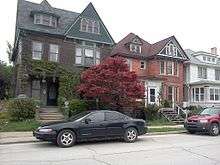Hubbard Farms, Detroit

Hubbard Farms is a neighborhood and historic district in southwest Detroit. It is located on one of the old plots which used to be a ribbon farm along the Detroit River. It is bound by Clark St to the west, W Vernor Hwy to the north, W Grand Blvd to the east, and W Lafayette Blvd to the south. In 1993, it received its received official historic district designation.[1]
History
Dating back before French fur traders colonized the Detroit area, the district was used by the Pottawatomie tribes as a local burial ground. After the area was colonized by the French in the 1700s, the land was granted to Robert Navarre, the royal notary at Fort Ponchartrain, who split the land grant into five ribbon farms along the Detroit River.
After the end of the War of 1812, many English immigrants in the area began to buy subplots and establish smaller farms. One of the first U.S. citizens to own land in the area was Whitmore Knagg, a military interpreter and frontier Indian fighter. He then sold some of this property to the Hubbard family in 1835.
The district was named after Bela Hubbard, a prominent local geologist, lumber baron, land agent, lawyer, farmer, historian and civic leader. In the 1830s, Bela made an early contribution to archaeology: as he surveyed the property, he realized that the area had once been a Pottawatomie village and burial ground. He conducted an excavation and discovered many tribal artifacts. When the State of Michigan was founded in 1837, Bela was named Michigan's first assistant geologist. [2]
Once the Civil War came to an end, Detroit experienced an influx of manufacturing jobs, which created a housing need. Hubbard Farms soon became home to executives and workers such as David Scotten, the owner of the Hiawatha Tobacco Works factory. In 1885, the district was incorporated into Detroit.
Much of the architecture in the community was designed and built between the 1880s and the First World War. Although the area has an overall Victorian feel, the time range for construction and the affluence of the area is reflected in diverse architectural styles and choices. The district features homes that display Romanesque, Colonial Revival, Beaux Arts, Federalist and even Italianate designs.
Places
Hubbard Farms has become a hub for artists and their spaces, with an unusual density of artist-in-resident or other places which carve out creative niches. This is seen in examples like SpreadArt and Southwest Housing Solution's Whitdel building. What Pipeline is a contemporary art gallery showcasing the best of international cutting edge artists. Hubbard Farm harkens back to its roots and shares in the current greening revolution with a community garden on Hubbard and a formal urban agriculture lot on Vinewood.
_Clark_Park_Mural.jpg)
There is a large park, Clark Park, currently managed by the Clark Park Coalition. It serves as the district’s “town square,” hosting festivals, fairs, sporting events and extracurricular activities for the youth in the community. The coalition emerged in 1991 as the community’s response to the closing of the park by the Detroit Recreational Department.

Nestled inbetween Mexicantown and Mexican Village, Hubbard Farms enjoys a wealth of Mexican cuisine and bodegas. Armando’s Mexican Restaurant, Los Galanes, Lupitas (to name only a few) and a smattering of food trucks are within easy walking distance.

Mexican Town Bakery - This bakery is one of two "locals" which offer traditional Mexican pastries, as well deli sandwiches. With the closing of Cafe con Leche, this bakery has added an espresso machine and seating, although it is not a primary focus.

All school grades are located within Hubbard Farms.
Maybury Elementary School - Located across the street from Clark Park this school has a very perceptible style of architecture, and its white brick stands out from the surrounding homes. Just like its counterparts, Western International High School and Earhart Middle School, the Latino population is evidenced in its student body, 78.7% Hispanic, according to the school’s profile report of 2009.

Amelia Earhart Middle School - On the southern edge of the Hubbard Farms is Amelia Earhart Middle School. This school is also a testimony to the current presence of the Latin American population in the area, with 59.7% of its students being of Hispanic descent.

Western International High School - Located across from Clark Park, this high school has evidenced the change in the demographics of the population in the neighborhood since it was built. The current impact of the Latin American immigrant community is evident in the composition of its student body, consists of 61.2% Hispanic or Latino students.
References
[1] [3] [4] [5] [6] [7] [8] [9] [10]
- 1 2 "Hubbard Farms Historic District" (PDF). City of Detroit Planning and Development Department.
- ↑ "The Renaissance man who envisioned Grand Boulevard". The Detroit News. 11 May 2014. Retrieved 11 May 2014.
- ↑ "Hubbard Farms Historic District".
- ↑ "Clark Park Coalition". Clark Park Coalition.
- ↑ "Maybury Elementry School". Detroit Public Schools.
- ↑ "Amelia Earheart Middle School". Detroit Public Schools.
- ↑ "Western International High School". Detroit Public Schools.
- ↑ "Armando's Mexican Restaurant". Armando’s Mexican Restaurant.
- ↑ "Mexicantown Bakery". Mexicantown Bakery.
- ↑ "Whitdel Arts". Whitdel Arts.
External links
| Wikimedia Commons has media related to Hubbard Farms Historical District. |
Coordinates: 42°19′08″N 83°05′24″W / 42.319°N 83.09°W
